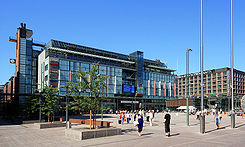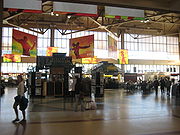
Transportation hub
Encyclopedia

Passenger
A passenger is a term broadly used to describe any person who travels in a vehicle, but bears little or no responsibility for the tasks required for that vehicle to arrive at its destination....
s and cargo
Cargo
Cargo is goods or produce transported, generally for commercial gain, by ship, aircraft, train, van or truck. In modern times, containers are used in most intermodal long-haul cargo transport.-Marine:...
are exchanged between vehicles or between transport modes
Mode of transport
Mode of transport is a term used to distinguish substantially different ways to perform transport. The most dominant modes of transport are aviation, land transport, which includes rail, road and off-road transport, and ship transport...
. Public transport
Public transport
Public transport is a shared passenger transportation service which is available for use by the general public, as distinct from modes such as taxicab, car pooling or hired buses which are not shared by strangers without private arrangement.Public transport modes include buses, trolleybuses, trams...
hubs include train station
Train station
A train station, also called a railroad station or railway station and often shortened to just station,"Station" is commonly understood to mean "train station" unless otherwise qualified. This is evident from dictionary entries e.g...
s, rapid transit station
Metro station
A metro station or subway station is a railway station for a rapid transit system, often known by names such as "metro", "underground" and "subway". It is often underground or elevated. At crossings of metro lines, they are multi-level....
s, bus stop
Bus stop
A bus stop is a designated place where buses stop for passengers to board or leave a bus. These are normally positioned on the highway and are distinct from off-highway facilities such as bus stations. The construction of bus stops tends to reflect the level of usage...
s, tram stop
Tram stop
A tram stop is a place designated for a tram to stop so passengers can board or alight it. Tram stops share most characteristics of bus stops, but because trams operate on rails, they often include railway platforms, especially if stepless entries are provided for accessibility...
, airports and ferry slip
Ferry slip
A ferry slip is a specialized docking facility that receives a ferryboat or train ferry. A similar structure called a barge slip receives a barge or car float that is used to carry wheeled vehicles across a body of water....
s. Freight hubs include classification yard
Classification yard
A classification yard or marshalling yard is a railroad yard found at some freight train stations, used to separate railroad cars on to one of several tracks. First the cars are taken to a track, sometimes called a lead or a drill...
s, seaports and truck terminals, or combinations of these. For private transport
Private transport
Private transport, as opposed to public transport, is transportation service which is not available for use by the general public. Private transport is the dominant form of transportation in most of the world. In the United States, for example, 86.2% of passenger miles traveled occur by passenger...
the parking lot
Parking lot
A parking lot , also known as car lot, is a cleared area that is intended for parking vehicles. Usually, the term refers to a dedicated area that has been provided with a durable or semi-durable surface....
functions as a hub.
Delta Air Lines
Delta Air Lines
Delta Air Lines, Inc. is a major airline based in the United States and headquartered in Atlanta, Georgia. The airline operates an extensive domestic and international network serving all continents except Antarctica. Delta and its subsidiaries operate over 4,000 flights every day...
pioneered the hub and spoke system for aviation in 1955 from its hub in Atlanta
Atlanta, Georgia
Atlanta is the capital and most populous city in the U.S. state of Georgia. According to the 2010 census, Atlanta's population is 420,003. Atlanta is the cultural and economic center of the Atlanta metropolitan area, which is home to 5,268,860 people and is the ninth largest metropolitan area in...
, Georgia
Georgia (U.S. state)
Georgia is a state located in the southeastern United States. It was established in 1732, the last of the original Thirteen Colonies. The state is named after King George II of Great Britain. Georgia was the fourth state to ratify the United States Constitution, on January 2, 1788...
, in an effort to compete with Eastern Air Lines
Eastern Air Lines
Eastern Air Lines was a major United States airline that existed from 1926 to 1991. Before its dissolution it was headquartered at Miami International Airport in unincorporated Miami-Dade County, Florida.-History:...
. FedEx adopted the hub and spoke model for overnight package delivery during the 1970s. When the airline industry was deregulated
Airline Deregulation Act
The Airline Deregulation Act is a United States federal law signed into law on October 24, 1978. The main purpose of the act was to remove government control over fares, routes and market entry from commercial aviation...
in 1978, Delta's hub and spoke paradigm was annexed by several airlines. Hubs make out the center of spoke-hub distribution paradigm
Spoke-hub distribution paradigm
The hub-and-spoke distribution paradigm is a system of connections arranged like a chariot wheel, in which all traffic moves along spokes connected to the hub at the center...
s, allowing passengers and cargo to be transported from one place to another without a direct service.
Public transport

Intermodal passenger transport
Intermodal passenger transport involves more than one mode of transport of passengers. Some modes of transportation have always been intermodal; for example, most major airports have extensive facilities for automobile parking and have good rail or bus connections to the cities nearby. Urban bus...
. Typical transport hubs in public transport include bus stations, railway stations and metro station
Metro station
A metro station or subway station is a railway station for a rapid transit system, often known by names such as "metro", "underground" and "subway". It is often underground or elevated. At crossings of metro lines, they are multi-level....
s, while a major transport hub, often multimodal (bus and rail), may be referred to in American English
American English
American English is a set of dialects of the English language used mostly in the United States. Approximately two-thirds of the world's native speakers of English live in the United States....
as a transport center or transit center. Sections of city streets that are devoted to functioning as transit hubs are referred to as transit mall
Transit mall
A transit mall is a street, or set of streets, in a city or town along which automobile traffic is prohibited or greatly restricted and only public transit vehicles, bicycles and pedestrians are permitted....
s.
Modern electronic Passenger information system
Passenger information system
A passenger information [display] system is an electronic information system which provides real-time passenger information. It may include both predictions about arrival and departure times, as well as information about the nature and causes of disruptions...
s and journey planners
Intermodal Journey Planner
An Intermodal Journey Planner , or Trip Planner is computer system which can provide a traveller with an itinerary for an intermodal passenger transport journey. The system can provide timetable, routing and other travel information...
require a detailed digital representation of the stops and Transportation hubs including their Topology
Topology
Topology is a major area of mathematics concerned with properties that are preserved under continuous deformations of objects, such as deformations that involve stretching, but no tearing or gluing...
. Public transport data information standards such as Transmodel
Transmodel
Transmodel is the CEN European Reference Data Model for Public Transport Information; it provides an abstract model of common public transport concepts and data structures that can be used to build many different kinds of public transport information system, including for timetabling, fares,...
and IFOPT have been developed to provide a common terminology, conceptual models and data exchange formats to allow the economic, large scale collection and distribution of stop and interchange data.
Airports
Airports have a twofold hub function. First of all they make it possible to concentrate a lot of passenger traffic from large areas into one place so the airlines have a good market. This makes it important for airports to be connected to the surrounding transport infrastructure, including roads, bus services and some places also railway and rapid transit systems.Secondly some airports also function as intra-modular hubs for the airlines, or airline hub
Airline hub
An airline hub is an airport that an airline uses as a transfer point to get passengers to their intended destination. It is part of a hub and spoke model, where travelers moving between airports not served by direct flights change planes en route to their destinations...
s. This is a common strategy among network airlines who fly only from limited number of airports and usually will make their customers change planes at one of their hubs if they want to get between two cities the airline doesn't fly directly between. Airlines have extended the hub-and-spoke model in various ways. One method is to create additional hubs on a regional basis, and to create major routes between the hubs. This reduces the need to travel long distances between nodes that are close together. Another method is to use focus cities
Focus city
In the airline industry, a focus city is a location that is not a hub, but from which the airline has non-stop flights to several destinations other than its hubs...
to implement point-to-point service for high traffic routes, bypassing the hub entirely.
Freight
Some of the most important transportation hubs are freight hubs. There are usually three kinds: sea-road, sea-rail and road-rail, though they can also be sea-road-rail. This is because the three main freight transport modes each have their own separate advantages concerning price, barriers and distribution. With the growth of containerizationContainerization
Containerization is a system of freight transport based on a range of steel intermodal containers...
, intermodal freight transport
Intermodal freight transport
Intermodal freight transport involves the transportation of freight in an intermodal container or vehicle, using multiple modes of transportation , without any handling of the freight itself when changing modes. The method reduces cargo handling, and so improves security, reduces damages and...
has become more efficient, often making multiple lags cheaper than through services—increasing the use of hubs.
See also
- Central stationCentral stationA central station usually designates the principal passenger railway station of cities which have multiple stations. The central station functions as the main transport hub for rail transport, normally with interchange with other modes of public transport...
- Junction (traffic)Junction (traffic)A junction, when discussed in the context of transport, is a location where traffic can change between different routes, directions, or sometimes modes, of travel.-Historical significance:...
- Intermodal Journey PlannerIntermodal Journey PlannerAn Intermodal Journey Planner , or Trip Planner is computer system which can provide a traveller with an itinerary for an intermodal passenger transport journey. The system can provide timetable, routing and other travel information...
- LayoverLayoverIn transportation, a layover, also known as lays over or stopover, is some form of a break between parts of a single trip.-In mass transit:...
- Infrastructure securityInfrastructure SecurityInfrastructure security is the security provided to protect infrastructure, especially critical infrastructure, such as airports, highways rail transport, hospitals, bridges, transport hubs, network communications, media, the electricity grid, dams, power plants, seaports, oil refineries, and...

